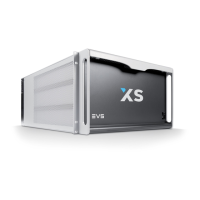If O and E represent respectively the odd and even fields of a standard video signal
(50/60Hz), we have:
The original video signal:
◦ O E O E O E O E O E O E O E O E
The output video signal at 50% speed:
◦ O O E E O O E E O O E E O O E E
The output video signal at 33% speed:
◦ O O O E E E O O O E E E O O O E
The output video signal at 25% speed :
◦ O O O O E E E E O O O O E E E E
Fields with parity violation are shown in bold, underlined letters. As it appears from the
above table, whatever the playback speed (with the exception of the normal 100%
playback speed), a number of fields violate the normal parity of the output signal. This
parity violation induces a 1-line shift of the field, resulting in a vertical jitter of the picture.
The jitter frequency depends upon the chosen playback speed.
To avoid this phenomenon and provide a stable output picture, EVS developed 2 types of
line interpolator: 2-line and 4-line interpolators. The interpolation process can be enabled or
disabled by the operator on all EVS slow motion systems.
2-Line Interpolator
The 2-line interpolator actually generates a new field, when the original field is in parity
violation. Each line of this new field is calculated by a weighted average of the 2
neighboring lines. This process solves the problem of parity violation and vertical jitter, but
the drawback is a reduction of the vertical resolution on the interpolated fields, that appear
unfocused. Another by-side effect is the alternation of original fields (perfectly focused)
and interpolated fields (unfocused), resulting in a "pumping" video signal.
4-Line Interpolator
The 4-line interpolator uses a more sophisticated calculation based on the 4 neighboring
lines. By using suitable coefficients for the weight of each line in the resulting calculation,
we apply this interpolation to all fields. The final result is a permanently, slightly unfocused
picture. The advantage is a stable output signal with no jitter and no "pumping", but the
vertical bandwidth is even more reduced.
The interpolator is of course always disabled at 100% playback speed, because there is
no parity violation.
EVS use the same techniques with the Super Slow Motion disk recorder, working with all
models of Super Motion cameras (150/180 Hz). The only difference between the
processing of Super Motion and normal scan (50/60 Hz) signals is that the interpolator is
always disabled at 33% playback speed, because the Super Motion signal does not cause
parity violation at this particular speed.
Whatever the choice, the resulting picture is thus always a compromise between stability
and resolution. With EVS systems, the operator always has got the choice between any
of the 3 above described techniques: no interpolation, 2-line interpolation or 4-line
interpolation. Even if the operator chooses to use the interpolation, this process will be
automatically disabled when not necessary (100% playback for 50/60 Hz signal, 33% and
100% playback for 150/180 Hz signal).
20 4. Software Specifications
EVS Broadcast Equipment S.A. -November 2011 Issue 11.00.A

